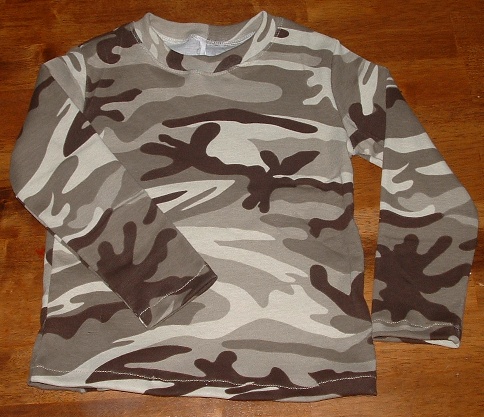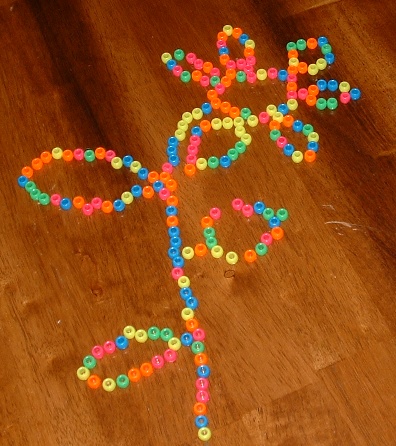I am getting a lot of visits from people googling "how to make a t-shirt" so I thought I'd oblige you.

First off, you need a pattern. You can trace one from an existing shirt, but I'm not covering that step in this tutorial. I'm using the size 4 t-shirt pattern from my beloved vintage Sew for Toddler. All the patterns for this book are on a large pattern sheet and you have to trace off the size you want. I usually trace my patterns onto freezer paper. If you look closely you can see I traced the wrong size first; I don't remember what happened there but it was one of two tracings I have of this pattern. My pattern has 4 pieces: front, back, sleeve, and neckband.

I have a pretty big piece of this fabric, so to waste the least amount of fabric and also be able to manage the whole thing, I cut out one pattern piece at a time. I'm starting with the front--the center front edge needs to be on placed on the fold of the fabric. I look closely at the fabric and make sure the tiny knit stitches are running straight (not at an angle) with my foldline. Also, the stretch of this fabric is going up and down in the photo, or across the body of the t-shirt front and back pattern pieces. You want to cut your knits out with the stretch going the right way.
This picture shows the front already cut out.

Then I do the same with the back. First I cut off the small amount of scrap from cutting the front and then I refold the fabric wide enough to do the back. Here you can see my cute pattern weights. I don't pin my patterns--I use pattern weights and rotary cut around the edges of my patterns. You can use scissors if you don't have a rotary cutter. I need to sharpen my scissors
and get a new rotary blade--cutting this out wasn't as easy and fun as it should have been.

The sleeve. Again I refold so I have enough width to lay out the sleeve pattern. See that long straight line? It's the pattern grainline and should line up with the grain of the fabric. In other words, line up with straight up and down lines of knitted stitches in the fabric. If you've ever had a t-shirt that twisted around your body when you were wearing it, it was cut off grain. It's not hard to make sure your fabric and patterns are on grain when you're cutting.

Neckline ribbing. This fabric is laid out with the stretch going left to right. The pattern piece is laid on the fold. I used a cotton/lycra ribknit for this piece. If your main shirt fabric is ribbed or fairly stretchy, you can use the same fabric for the neckline. This shirt fabric is a jersey that's not really stretchy enough to go over my boy's head and not have stitches pop right away.

Here are all the pattern pieces cut out.

Sewing step 1: Place front and back pieces together with right sides facing. Match the pieces up at the shoulder and pin them if you want.

Here they are serged together. Before I had a serger I would sew the seam, then zigzag the edges together because I don't like unfinished edges.

Sewing step 2: Pin the top center of the sleeve to the shoulder seam.

Pin the front and back edges of the sleeve seam. This is kind of difficult to show in a photo.

Here's the shirt with both sleeves sewn on.

Sewing step 3: Fold the shirt so the front and back line up and the sleeve edges line up. Starting at the sleeve hem edge, and all at once, sew the sleeve edges together, then the front and back together at the sides. Do both sides.

Here's the shirt with sleeve/side seams sewn.
Sewing step 4: Sewing the neckband on is explained
here in my T-shirt neckband tutorial.

Sewing step 5: Fold the sleeve edges and bottom edge up once and stitch in place. I have a "why you don't need a free arm to sew hems of small sleeves" tutorial that I'll share soon.
There you go!




















